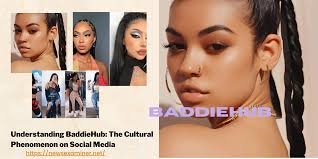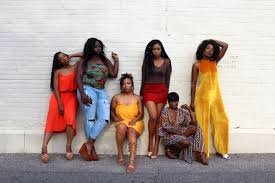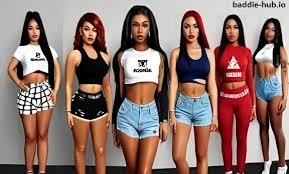Table of Contents
Introduction to BaddieHub
BaddieHub has launched into the digital scene and is causing quite a commotion. Its dedicated community and powerful aesthetic provide confidence to those willing to adopt the baddie culture. But with the fame comes the question, what is hidden underneath? In this article, we aim to address BaddieHub further, looking at its attractive side and its associated issues and challenges. In today’s society of brash images and minimal ideas, where is BaddieHub situated? Let’s traverse this in more detail by examining all facets of the remarkable but controversial industry.
The Rise of Baddie Culture

Baddies have become prominent figures in today’s fast-paced social media world, which accommodates platforms such as Instagram and TikTok. Self-expression, breaking traditional conceptions of beauty, and flaunting self-confidence through bold fashion trends have made baddies this world’s most captivating trend.
Baddies accentuate their fierce femininity and individuality through a blend of self-available and androgynous trademarks that self truly define them. As the #Baddie movements become overwhelmingly trending and engaging, this enables people to ask – What does it mean to be a baddie in today’s world?
Apart from the looks, the attitude carries a considerable influence, and many consider this an inspiring movement because it allows women to reclaim their narratives rather than allowing society to shape the story for them. When this craze takes center stage, many young girls are pulled into the enticing allure of becoming a baddie, which is the exact intersection of charm and empowerment necessary to redefine societal expectations regarding beauty and etiquette.
This trend hasn’t just made a small impact on society or social media. Its long-term vision is far more profound and entwined with society as a whole. This movement won’t die down anytime soon.
What is a Baddie?
To start, being a baddie means embodying an incomparable zest for life. Baddies possess confidence and style that sets them apart. Undoubtedly, one can know a baddie just by looking at their outlandish attitude and fashion.
Baddies usually blend glamour and streetwear, like jackets, with tighter clothing, which makes them stand out even more. They don’t even try to speak; they instead let their clothing do the talking or, in their case, the shouting.
When it comes to defining a baddie, social media platforms play a pivotal role in portraying the image—especially Instagram! Have you ever encountered influencers taking selfies with an eccentric mixture of aesthetic feeds? Well, there you go! That’s how a baddie looks.
Self-governing yourself and being confident with what you’re wearing are the core foundations of being a baddie. Women don’t just reject self-hate but embrace who they are and spread the message of being confident in your skin through body positivity and encouraging self-love.
Baddie culture allows women to think outside the box and be fearless with their creativity, which has become a necessity in the modern world.
Controversies Surrounding BaddieHub

Whether it be shedding light on women’s rights or attention to body positivity, BaddieHub or Bad Bitch Hub, as some like to call it, has made a thunderous entry into today’s media landscape. And without a doubt, controversy is sure to pop up where there is power. And BaddieHub is no stranger to such controversies. Most critics point to the platform’s normalization of beauty standards that are hardly ever real. Most claim it portrays an unrealistic image, setting an unattainable standard for younger women.
Moreover, there has been ongoing discussion on how influencer culture affects one’s mental health. Users often feel less worthy when they compare their raw selves to influencer posts, which leads to a vicious cycle of self-hate.
Furthermore, some question whether BaddieHub is contributing to rising materialism for the sake of fashion. The obsession with high-end fashion items can defeat the purpose of working on oneself and building a unique personality.
There has also been controversy regarding community dynamics on BaddieHub.
To begin with, some find comfort in unity over shared aesthetics, while others feel isolated for not fitting the box of what a ‘baddie’ is supposed to look like. Such controversies show how layered online communities catered around identity and style are.
The Dark Side of Baddie Culture

In recent years, we have seen the rise of ‘baddie culture’ and its related implications. This trend portrays a lifestyle that is often unrealistic and difficult to maintain; however, it may be appealing. The addition of materialistic trends only further the issues society faces with beauty standards in an already competitive world.
Young baddie influencers often feel the need to fit into this baddie mold, which can lead to very negative life-affecting consequences. Going on social media and seeking fame, followers, or even ‘likes’ quickly becomes a goal.
One core tenet of baddie culture is consumerism, which can again overshadow essential aspects of life, such as relationships and personal growth.
Baddie culture also promotes substance use and partying at times without explaining the potential consequences; this can be a significant issue as many do not take the risks seriously.
This form of competition is counterintuitive, as many begin to focus only on external competition instead of self-improvement. This behavior does not empower women; instead, it promotes a hunt for superiority.
As mentioned above, there are many issues linked with baddie culture and its core tenets; the sheer brutality of looking beyond the superficial flaunting of confidence is alarming and requires further conversation.
Impact on Young Girls and Society
BaddieHub has an enormous influence on the lives of young girls. On social media, images and lifestyles that portray the notions of beauty, confidence, and glamour are in absolute abundance. These standards are truly unrealistic, and many young teens readily buy into this aesthetic.
This leads to the development of skewed notions of self-worth. Girls may integrate their worth in terms of appearance rather than what they have achieved or their character. This forms a never-ending cycle of comparison that leads to anxiety and low self-esteem.
Furthermore, the portrayal of such femininity enacts rules in society about beauty and how females ought to act. There are good chances young girls would be forced to wear masks in the name of such beauty standards and lose their identity just to get accepted.
These trends have more extensive repercussions on the cultural narratives about empowerment and success. Instead of appreciating womanhood in all its nuances and forms, there is a danger of once again limiting what it means to be a woman and constituting something homogenous, which diminishes the individuality of the subsequent generation. These accumulating changes reflect new ideologies that need different communities to think through, as baddie culture brings up much complexity.
Alternatives to Promoting the Baddie Lifestyle
Finding new ways to express oneself aside from the baddie lifestyle can be empowering. Instead of emphasizing the look, why not combine beautiful things and create art that celebrates uniqueness? Art or fashion creation encourages inventiveness and assurance that goes further than how one looks.
Speaking of what, mental health, as well as wellness, is essential. Promoting children or encouraging young girls to practice mindfulness activities such as yoga or meditation strengthens them. Such exercises deal with the self rather than the outside world.
Community involvement is a great way to focus that energy in a healthier direction. Working with social outreach projects or local organizations adds a feeling of redistribution while building compassion.
Most importantly, having various other role models who portray different definitions of success gives children encouragement to follow their hobbies, with no restriction besides what the social media fad dictates. Each alternative opens the doors to a more positive view of life and personal success.
Conclusion
BaddieHub has emerged as a powerful force in the media baddiehub landscape, dancing to the beat of the times while determining them. Rooted in baddie culture, it gives a glimpse into a lifestyle that millions wish to further possess. And yet, it is worth mentioning the pros and cons of self-presentation and the definition of self-identity—as a concept, empowerment, and self-expression.
The changes in society and what influence and identity creation mean to young girls continuously change. BaddieHub is an excellent example of how culture can alter analysis for many, but it also raises issues of authenticity, mental health, and societal norms.
We do see the importance of looking for alternatives that reaffirm a sense of worth deeper than outward appearances to build more positive spaces for youth. Whether through strong networks that connect people or artistic activities that promote an expanded definition of beauty and strength, the shift from stereotypes to complexity may lead to a more even perception.
This new space in culture has to be approached with caution—by those who use platforms like BaddieHub and by content creators. There is an ongoing discussion about what being true to yourself means, especially in the context of wider social frameworks on beauty and empowerment.
